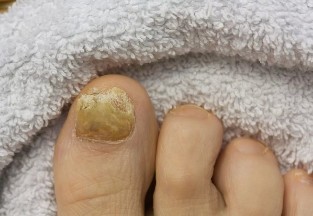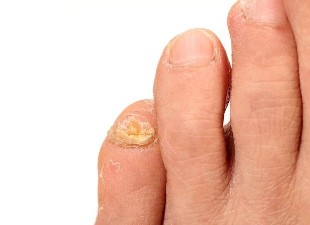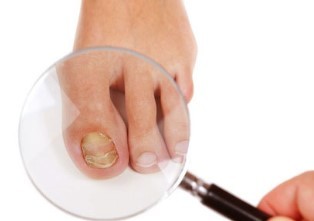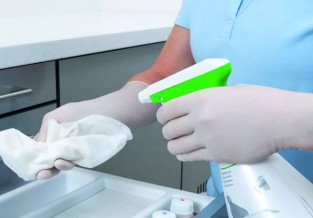There is almost nobody had heard about this pathology, such as nail fungus. Someone familiar with the diagnosis of the advertising pharmacological means, and someone who has learned about the disease is not hearsay, coming out of the office of a dermatologist or one of his by the diagnosis.

Definition
The medical term onychomycosis (lat. onychomycosis (om) in the translation from the latin, means the nail fungus, and is an infectious disease of fungal origin and nature. This is the most widespread in the world of the defeat of the nail plate and adjacent to the soft tissue: according to the statistics of the world health organization (WHO) mycosis feet suffer approximately 27% of the population, this rate is almost two times greater than the amount of fungal infections of the nails on the fingers of one hand.
Types of fungal diseases of the nails
Onychomycosis agreed to classify the appearance of the affected areas. As a sign of the classification is like the air of nail fungus, it is distinguished by three types, depending on the clinic:
- atrophic, or onycholitic – in which the nail plate significantly affected, to the extent of tearing away from the nail bed;
- hypertrophic, which has lost natural shine nail color changes (white or, on the contrary, darkens) and the structure (large thicker) with the appearance of a different kind of deformations and even collapse on the edges;
- normotroficheskie – view, characterized by the low level of corruption, in which the nail plate is not thickened, while remaining shiny and smooth, but all the same on the outside, is transformed through it, stains, scratches, and other visible changes natural transparency and colour.
There is another classification, according to which the mycosis of nails is divided into types depending on the specific position of the defeat:
- total, which is pathogenic on the subject of the process of understanding all the nail plate;
- distal – the form of hitting only on the free edge of the nail, occurring above the tip of the finger;
- proximal, which destroys the edge of the plate, coming out from under the nail of the roll (in front of the free edge of the nail!);
- the calf form of lesions affecting the sides of the nail.

What looks like pathology
Prevalent among the populations of the fungal diseases of the nails have external similarity with other dermatologic diseases, not fungal in nature. Depending on the stage of the pathology, the nails begin to be painful, as they lose their natural radiance and transparency.
From smooth and level, they become thick and distorted, and covered with a different color (often a or off-white and yellow) patina. The soft tissues, destructible parasite keratin layer is also involved in inflammatory reactions swelling.
If we consider the image of the destruction of the plate in the view of the dynamics of the disease, it can be divided into three stages:
- During the first phase of virtually no signs, light tarnish, spots or bands on the disk.
- On the so-called expressed-by-step, the rapid evolution in the beginning, all the symptoms of onychomycosis is obvious.
- Launched phase is the limit of the degeneration of the nail, can be supplemented by the advent of the smell of the decaying tissue.
The symptoms of nail fungus
The onset of symptoms of the fungus conditional corresponds to the chronology of the pathogenic development of the process, the speed of which depends on the specific type of the pathogen and the individual characteristics of the health status of the patient.
So how to determine the nail fungus until the visit to the office of a dermatologist? A close look at the characteristic symptoms that accompany the fungal of the defeat of the nail plate on the fingers:
- First of all, the nail plate lose their brilliant luster, becoming dull and rough.
- Then, transparent and pink nail changes color, becoming whitish, grey or broken-yellow.
- The thickness of the plate increases.
- On the surface of the body defects appear in the form of stripes, waves, ripples, bends, etc
- The nail appears to be the fragility, it starts flaky and crumbles.
- Fingers due to the accumulation of inflammatory processes begin to emit an unpleasant odor.

In the end, completely destroyed the nail is submitted onycholysis, that is to say, the peeling off, exposing pringtime bed.
The reasons for onychomycosis
The pathology is one of the manifestations of the fungal infection, which represents a defeat in this case, the plate micro-dermatophytes one (or more!) from three layers:
- Microsporum (view canis);
- Trichophyton (types rubrum – 90% of all fungal infections, mentagrophytes, interdigital, and tonsurans) are the most frequently encountered by pathogens for fungal infections;
- Epidermophyton (view floccosum).
Representatives of all three of the delivery, are collectively called the "mushroom of the nail", the ingestion of colonize (that is to say, localized) keratinized derivative of the epidermis of the skin:
- nails;
- hair.
The reason for this distinction habitats of micro-parasites lies in their nutrition: all the representatives as a source of energy using fibrillar protein called keratin, by destroying nails and hair.
Methods of infection
All types of pathogens causing diseases are transmitted to the contact method:
- the physical contact of an infected person to the health;
- through the things that are in contact with those parts of the body (shoes, personal items, etc).
The contact with the nails or of the skin, which is become the dwelling place of the parasite, you can living representatives of the mushrooms to reach the healthy parts of the body.
By doing this, the pathogen is a onychomycosis has been able to achieve the infiltration in the tissues of man, requires conditions such as:
- damage to the integrity of the skin (dermatitis, diaper rash, vascular and skin diseases, sores, wounds, etc);
- the decrease in immunity;
- the presence of comorbidities (genodermatosis and hemolytic disease of the immune and the endocrine system);
- the reception cytotoxic and hormonal drugs, as well as antibiotics.

Therefore, the penetration of the parasite in the body of a person in good health is not in all cases, leading to clinical manifestations of the disease, or only very weakly expressed forms of the pathology.
Because of certain individual conditions, including and a strong immune protection, the man, while remaining outwardly healthy, is a carrier of a parasite infecting other people.
How to recognize the disease
For a reason external similarities mycotic lesions, mechanical deformations, and symptoms of other pathologies nail plate, depending on the clinical diagnosis is not just the external signs — such as the air of nail fungus, and again, and to complement results of micro-research.
For laboratory analysis are used to particles of sites of the victim to the nail, producing a scraping of the nail fungus of any special tools.
A specific aspect of the parasite are identified by two more practices of the research:
- the culture, by the insertion of a biological sample of the affected tissue in a nutrient medium;
- molecular biological method, or the so-called polymerase chain reaction (PCR).
More accurate and informative of the DNA is not yet sufficiently widespread.
In response to the question: "how to recognize nail fungus at home", has known dermatologists advise all the same to see a specialist for a complete outfit, and, if applicable, and differential diagnosis.
That dangerous nail fungus
Single symptoms of nail fungus is, though unpleasant, but for fungal infections: dissection of the nail, pain, etc
But in some cases, mycotic can join, for example, a bacterial infection or the disease may be acute, with a severe blistering, ulcerations, weeping sites on the soft tissue.
Happens, medical treatment, long-term performed in an outpatient setting over 16 weeks!), is not ineffective, and the disease progresses.
That dangerous nail fungus, sustainable inoperable? In the inflammatory process involved bodies and of their system, and then you may need emergency hospitalization of a patient.
The methods of treatment of nail fungus
In the early stages of the disease, official medicine adheres to methods of conservative and by the designation of a drug treatment.
Anti-mycotic drugs designed to destroy the fungus under the nail, contain substances that may actively oppress the livelihoods of the variety of its timbres. To achieve the effectiveness of the treatment can be used pharmacological different forms, sometimes named in a comprehensive way:
- pills taken orally (through the gastrointestinal tract, usually in drinking water), is prescribed in the absence of the desired effect, outside of medication;
- ointments, pastes and gels for the premises, outdoor applications, with the application of medication directly on the area affected by the parasite part of the body;
- aerosols;
- the solution (resorcinol, boric acid, brilliant green, et al) and the suspension, for an application of the tool towel on the affected area, or the use of a drug in the form of healing baths.
Medicines for external use use it usually twice a day, until the resolution of clinical manifestations. In the case of an important keratosis to facilitate the penetration of the dosage form, the depth of the keratin of education play a partial detachment. If the symptoms of nail fungus show support a secondary bacterial infection, the patients are recommended combination of antibiotics.
It is important! If the use of an Anti-mycotic means for controlling the potential of functional disorders necessarily produce biochemical of the liver (analysis of blood serum for the presence of bilirubin, the presence of the enzyme aspartate aminotransferase, gamma-gloutamiltransferazy et al.
If the patient, the physician, for example, the fungus of the nails on the thumb, all of a sudden appear of acute inflammatory processes and/or itching, have recourse to means:
- antihistaminicas (swelling and inflammation);
- desensitize (reducing the sensitivity).

Therapy by the use of pharmacological means, is usually changing, and takes a long period of time – at least three months!
This duration of treatment is explained by the introduction of the pathogen into the structure of the nail, and that the time needed to update it, with the consequent of the circumcision of the affected areas. In the case where the disease is at a stage when the medication treatment does not give positive results (the form), or the patient is a person with senile age, the use of radical methods, removing surgically destroyed the parasite with a fingernail.
Prevention
The best treatment is the prevention of events, because to avoid the disease is much easier than to first settle the mushroom of the nail, and then get rid of him. Good ways to prevent the infection plays the strict observance of rules of personal hygiene, especially in public places, threats to the potential danger of contact with the carriers of the fungus, as well as prevention:
- primary, in the form of exceptions in abnormal dryness of the skin, wear, strain injuries and hyperhidrosis, and, in the case of the appearance of treatment in a timely manner, for example, aluminium hydrochloride 15% with ditilinom glycol 1% with the increase of the perspiration of the feet;
- secondary disinfection with special solutions of objects in contact with an outbreak of fungus (shoes, towels etc).
Placing the information is correct, what appears to be nail fungus, it really is protecting you and your loved ones against infection, and in the case of the disease in a timely manner and appropriate treatment methods are able to speed up the recovery.






























